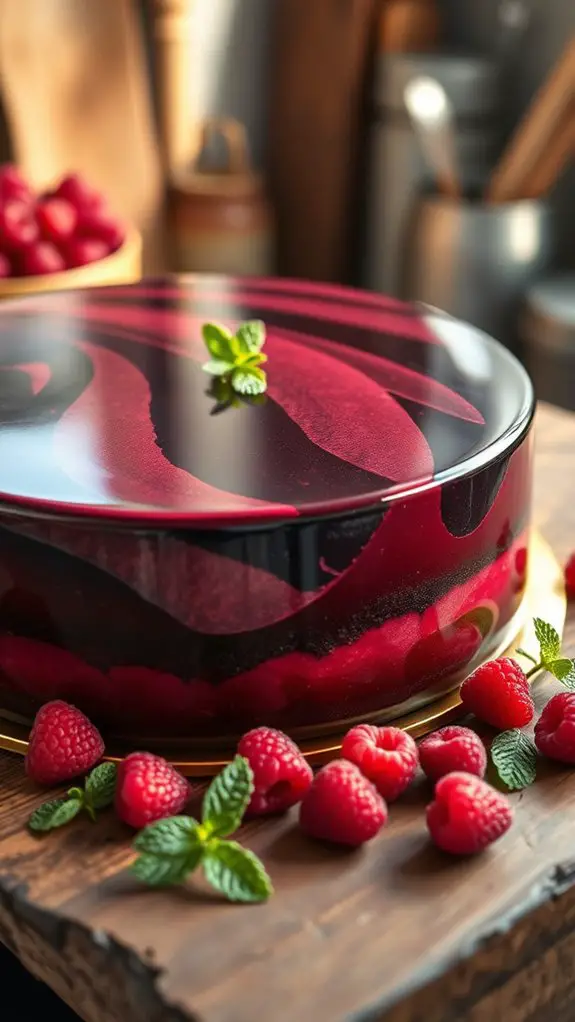You've got to try this mirror glaze technique. It'll transform your cakes and pastries into mesmerizing showpieces. The glossy, reflective coating creates a stunning visual appeal that'll wow your guests. But mastering the perfect temperature and application is key. Get it right, and you'll elevate your desserts to new heights. Dare to experiment with vibrant colors and unique flavors – the possibilities are endless.
History

Although the exact origins of mirror glaze remain unclear, its history can be traced back to the early 20th century. The innovative technique emerged from the French pastry tradition, where creative confectioners sought to elevate the visual appeal of their culinary art.
By blending gelatins, sugars, and flavorings, they developed a glossy, reflective coating that could be draped over cakes and desserts, creating a mesmerizing illusion of depth and shine.
This visually striking technique quickly captured the imagination of pastry chefs worldwide, transforming the way they presented their delectable creations.
Today, mirror glaze continues to push the boundaries of the culinary arts, inspiring bakers to create ever-more enchanting and visually stunning desserts.
Recipe

Mirror glaze is a glossy, reflective coating that's often used to finish cakes, desserts, and other confections. This technique creates a smooth, shiny surface that's both visually stunning and delectable.
To achieve the perfect mirror glaze, it's crucial to follow the recipe carefully and pay attention to the temperature and consistency of the mixture. The end result will be a beautifully reflective, flawless coating that will surely impress your guests.
Ingredients:
- 1 cup (240 ml) water
- 1 cup (200 g) granulated sugar
- 2 tablespoons (30 ml) light corn syrup
- 2 envelopes (4 teaspoons/20 ml) unflavored gelatin
- Food coloring (optional)
Instructions:
In a medium saucepan, combine the water, sugar, and corn syrup. Bring the mixture to a boil over medium-high heat, stirring constantly until the sugar has dissolved.
Remove the pan from the heat and sprinkle the gelatin over the surface. Whisk the mixture until the gelatin is completely dissolved.
Allow the glaze to cool to approximately 90°F (32°C) before using.
Tips:
For the best results, use a high-quality gelatin and verify that the glaze is the correct temperature before pouring it over your dessert.
To achieve a mirror-like finish, the glaze should be poured in a thin, even layer. Allow the glaze to set completely before serving.
Nutritional Guide
While the mirror glaze's striking appearance may captivate, it's important to reflect on its nutritional profile. The caloric content may surprise, with a single serving packing a punch of over 200 calories.
However, the ingredient benefits shine through. The sugar content, derived from the sweetened condensed milk, provides a quick energy boost. Gelatin, the gelling agent, offers collagen-enriching benefits for skin and hair.
Combining the indulgent taste with strategic nutrition, mirror glaze can be enjoyed as an occasional treat, striking a balance between decadence and wellness. Mindful portions are key to savoring this visually-appealing delight without compromising your health goals.
Final Thought
Savor the mirror glaze's striking visuals and strategic nutrition, striking a balance between decadence and wellness.
Release your creativity with serving suggestions that showcase the mirror glaze's versatility. Drizzle it over cakes, dollop it atop fruit tarts, or even use it as a dipping sauce for fresh berries.
The mirror glaze's translucent sheen and vibrant hues elevate any dessert, transforming the ordinary into the extraordinary.
Explore innovative techniques to craft custom mirror glazes, playing with colors and flavors to delight the senses.
Indulge mindfully, savoring each luscious bite that nourishes both body and soul.
The mirror glaze's final flourish is a demonstration of the power of edible artistry.